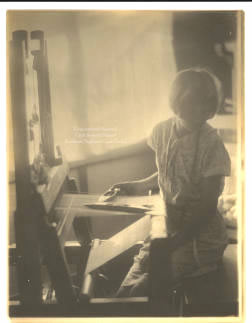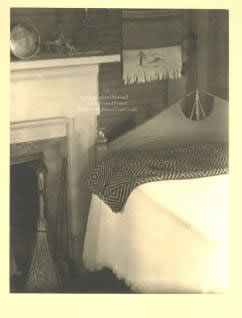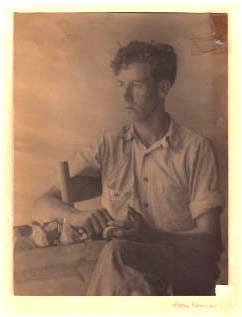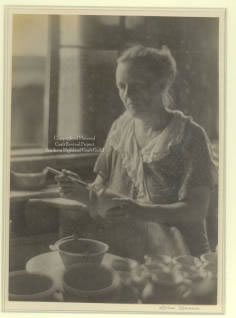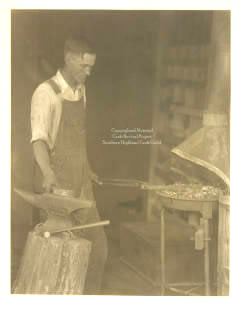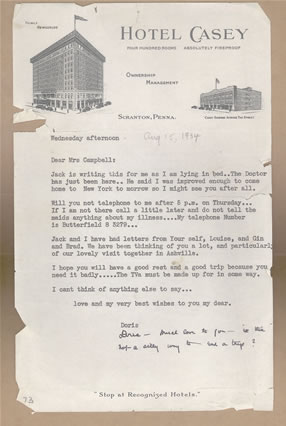The People:
Doris Ulmann
Doris Ulmann (1882-1934) was already a successful photographer when she met Allen Eaton in the 1920s and became involved with the Craft Revival. In the 1930s, when Eaton began organizing exhibitions of southern mountain crafts, Ulmann’s photographs of craft makers at work provided context. An indefatigable artist, Ulmann made photographs right up until her death in 1934. In 1937 fifty-eight of her photographs were published in Eaton’s Handicrafts of the Southern Highlands. In 1971 her assistant John Jacob Niles published sixty-three photographs in The Appalachian Photographs of Doris Ulmann. In 1976, the art department at western Carolina University mounted a retrospective exhibition of her work. 1
Like many non-makers who participated in the Craft Revival, Doris Ulmann was born outside the region to a wealthy family. The daughter of a Jewish textile industrialist, Ulmann was raised in New York City’s fashionable Upper West Side. She spoke German, French, and Italian in addition to her native tongue. In 1923, after ending a failed marriage to Charles Jaeger, an orthopedic surgeon and fellow photographer, she moved to an apartment at 1000 Park Avenue, where she lived until the end of her life. Always frail, Ulmann stood five-feet-four and weighed just over 100 pounds. She was a smart dresser who employed a dressmaker and Fifth Avenue boot-maker. Ulmann enrolled at Columbia University and the Clarence White School of Photography, which attracted such notable photographers as Margaret Bourke-White and Dorothea Lange. She was among the founding members of the Pictorial Photographers of America, a group that attempted to make pictures that were expressive, artistic, and beautiful. Through her interest in the Ethical Culture Society, which advocated that cultural differences contribute to a democratic society, 2 Ulmann began looking at her photographic subjects not as individuals, but as universal cultural types.
Doris Ulmann’s earliest portrait subjects were those who shared her world. She invited well-known writers to sit for her in her Manhattan apartment. One of her subjects commented on Ulmann’s method of using props:
You select your own chair...[and pose] with or without pipe, cigarette, ukulele, or volume of the Encyclopedia...Ulmann would say that these things are offered to “draw you out.” She studies your hands as you pass her a plate of cakes, observes which leg you cross over the other...tells you a funny story to make you laugh, and another not so funny to see if you are easily reduced to tears. 3
But, more and more, Ulmann photographed what she called “vanishing types.” She made an early picture series of esoteric religious sects: Shakers and Mennonites in Pennsylvania, and Dunkards (German Baptists) in the Shenandoah Valley of Virginia. In the late 1920s she traveled to rural Kentucky where she took pictures of mountain families and to coastal South Carolina where she turned her camera on the African American Gullah people.
Although she worked on the cusp of the modern age, Ulmann’s photographic method belonged to the 19th rather than the 20th century. She used a heavy 6 ½” x 8 ½” view camera that required a cumbersome setup. Composing a picture with a view camera was complicated by the fact that the image appears upside down and backward to the photographer looking through the view finder. Ulmann did not use a light meter to measure how much light an exposure required. Instead, she removed the lens cap by hand to allow light to reach the film. Exposures were made on glass plates, producing full-sized photographic impressions that were then printed on platinum paper. Although expensive, platinum allowed for a subtle range of grays, resulting in a wide tonal palette.
During her lifetime Doris Ulmann created portrait portfolios of medical doctors (1919 and 1922), editors (1925), and African Americans in the volume Roll, Jordan, Roll (1933). She mounted a solo exhibition of her work at the Library of Congress only months before she died. Most of her Appalachian portraits were published posthumously with many printed from some of the 10,000 glass plates left at her death in 1934. In 1937 many of Ulmann’s Appalachian images were published in Handicrafts of the Southern Highlands, Allen Eaton’s survey of the Craft Revival. As an independently wealthy artist, Ulmann was in a position to determine the circumstances of her work. She rejected Eaton’s request that she follow him, taking portraits of every craftsman he visited. Instead, she set her own schedule and spent lengthy afternoons with one subject. Ulmann approached her portraiture of craft makers and movement leaders in much the same way as she did her Manhattan subjects. Using a soft-focus lens, she posed each with some tangible symbol of the sitter’s role. Revival leaders were often posed with books, makers with the tools of their trade. 4
Ulmann’s portrait lens began to focus on Appalachian craftsmen in the 1920s. Asked first by the Southern Woman’s Educational Alliance of Richmond, and later by author Allen Eaton, Ulmann began regular photographic pilgrimages to eastern Kentucky, southwestern Virginia, and western North Carolina. In Asheville, she stayed at the Battery Park Hotel; in Murphy, she lodged at the Regal Hotel. In the summer of 1933 Ulmann traveled for the first time to the John C. Campbell Folk School in Brasstown, North Carolina where she met school founder Olive Dame Campbell. Eaton wrote ahead to Campbell. “Mrs. Ulmann left early this morning with John Jacob Niles for Murphy where they expect to arrive on Saturday…Mrs. Ulmann does not seem to me any too strong and I am glad she has that husky young man to help her in the work.” At the folk school Ulmann made portraits of assistant school director Marguerite Butler and director Campbell. Campbell became a close friend and colleague, putting her in touch with western North Carolina craft makers. Ulmann wrote of her trip to the folk school as a “landmark in my life;” to Campbell she wrote, “You have become part of our lives.” But Olive Campbell was more than just a friend to Doris Ulmann; she gave advice and drew itineraries for the photographer to follow. In 1933 Ulmann took photographs in Asheville of Clementine Douglass at the Spinning Wheel and in Hickory at the Hilton Pottery. She met Frances Goodrich and made a portrait of her as well. On her way back North she stopped at the Whitetop Mountain music festival outside Marion, Virginia where the guest of honor was Eleanor Roosevelt. She would meet Roosevelt a few months later when her work was on exhibit in Washington DC. 5
Most of the photographs Doris Ulmann took in western North Carolina were made during the last two years of the artist’s life. With frail health exacerbated by chain smoking and a poor diet, 1933 and 1934 were spent on the road, punctuated by shorter and shorter stays in Manhattan where she would develop pictures, recoup and repack, before heading out again. Ulmann ventured out from her Park Avenue apartment in a large Lincoln driven by a German chauffeur. With equipment in the trunk and map in hand, they often left on extended photographic tours at midnight. She sometimes processed photographic plates in hotel bathrooms, renting out an extra room for that purpose. Niles wrote of one of their last departures, “On about the 10th of April (1934) the 7th Ulmann Niles Folk Lore Photographic Expedition will set out. With cars and trailers and cameras and note books.” 6
Doris Ulmann’s last photographs were made on Turkey Mountain, not far from Asheville, North Carolina. She had been ill on this trip and brought along a nurse who traveled with her from New York. Niles commented on Ulmann’s tenacity and determination.
[She was] willing to put up with any kind of weather, any kind of heat, any kind of rain…for the sake of getting to some out-of-the-way, God-forsaken spot where some ancient with a long white beard and a shock of white hair was sitting in front of his little cabin.
Ulmann knew that her health was failing and wrote to her friend Olive Campbell the prophetic words, “I wish that I could look forward to the time when I’ll be visiting you at Brasstown again.” A month later Doris Ulmann collapsed and was taken by car back to New York City. She stopped in Pennsylvania to rest and wrote two last letters to Campbell. She noted her weakened condition, explaining her handwriting “is scrawly because I am writing in bed.” 7 Doris Ulmann died on August 28, 1934 at her Park Avenue apartment.
- M. Anna Fariello, 2007
See More: Photographs by Doris Ulmann
1. Doris Ulmann: Photographs of Appalachian Craftsmen (Cullowhee NC: Western Carolina University, 1976).
2. John Jacob Niles, The Appalachian Photographs of Doris Ulmann (Penland, NC: Jargon Society, 1971), unpaginated.
Philip Walker Jacobs, The Life and Photography of Doris Ulmann (Lexington: University of Kentucky, 2001), 6.
3. Quote from Dale Warren, “Doris Ulmann: Photographer-in-Waiting,” Bookman (October 1930): 131. Using props in artistic compositions is an historical artistic practice. Common during the Renaissance, saints were depicted with attributes of their character. A portrait of Ulmann shows her hugging an oversized view camera in Olive D. Campbell, “Doris Ulmann,” Mountain Life and Work (October 1934), 11.
4. Julia Peterkin and Doris Ulmann, Roll, Jordan, Roll (New York: Ballou, 1933). Allen Eaton, Handicrafts of the Southern Highlands (New York: Russell Sage, 1937). Contemporary scholars debate whether Ulmann was a documentary photographer, given that she so often staged her photographs. Melissa A. McEuen acknowledges this academic point of contention in the title of her chapter on Ulmann, “Documentarian with Props,” Seeing America: Women between the Wars (Lexington: University of Kentucky, 2000). For a discussion of Ulmann’s conflict with Eaton, see McEuen, 68.
5. Allen Eaton to Olive Dame Campbell, July 13, 1933; Doris Ulmann to Olive Dame Campbell, August 7, 1933; Doris Ulmann to Olive Dame Campbell, August 14, 1933. All three letters in the John C. Campbell Folk School Archives.
6. John Jacob Niles to William Hutchins, March 11, 1933, Berea College Archives.
7. Niles quote from McEuen, 38. Doris Ulmann to Olive Dame Campbell, July 27, 1934; Doris Ulmann to Olive Dame Campbell, August 11 and August 15, 1934. Both letters are in the John C. Campbell Folk School Archives.
